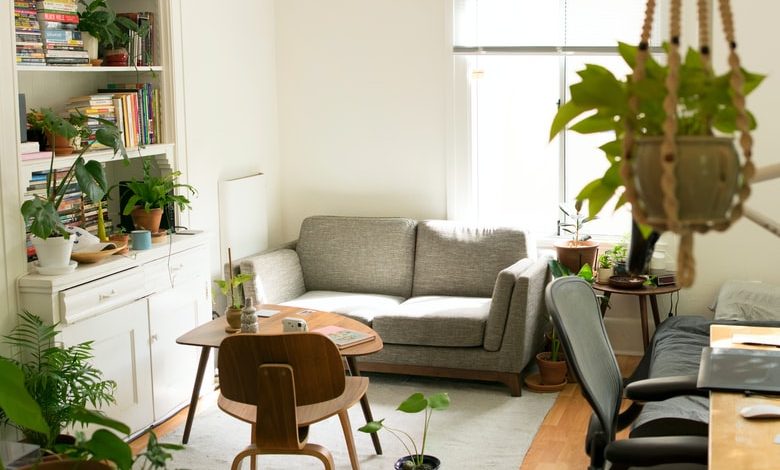Helpful designing tips for small houses

Designing a small home can be more difficult than designing a large one. That’s because you don’t have the luxury of working with as many large pieces of furniture or as much space for entertaining guests.
But that doesn’t mean you can’t flaunt your style and design sense. You simply just have to be a little bit more creative and have a good eye for what works and what doesn’t.
Here are some practical tips for furnishing a small space:
Go vertical
When working with limited floor space, you have to take advantage of every inch of vertical space at your disposal. Consider hanging shelves along the walls for displaying knickknacks and larger items like books, paintings, or plants. You could also invest in a closet organizer that has shelves, so you can maximize storage potential inside your closets.
Use mirrors
Mirrors are great for creating the illusion of more space, so if you need an extra kick in the visual department, hang up several mirrors throughout your small home. If they’re hung at different angles, they will reflect light in lots of alternative ways and make it seem like there is more light flooding the rooms than there actually is.
Select an overall theme
When you have a lot of different elements in a room, it can feel disjointed and overwhelming. That’s why it’s best to select an overall theme and stick with it throughout the room. For example, if you’re going for modern and minimalist, use that as your guiding principle when choosing furniture and accessories.
Choose your furniture carefully
Be selective in what furniture you choose to bring into your home. The general rule of thumb here is that bigger isn’t consistently better. When shopping for furniture, try to find pieces that have clean lines and aren’t too bulky. They should be functional yet also aesthetically pleasing. Additionally, avoid getting anything with glass tops as they tend to reflect light when placed near windows which can create glare and make a room appear smaller than it actually is.
The best colors for a smaller space
Your color scheme should also rely on basic and flexible colors enough to go with anything and be easy to combine. Your best bet? Stick with neutrals such as black, white, and shades of gray and use them as the building blocks for your color scheme. Add pops of bright or bold colors sparingly — they’re great accents rather than focal points.
Be mindful of proportion
It’s natural to want to fill every inch of free wall space with decor, but it’s often better to use smaller items that pack more visual punch than larger ones that can dwarf everything around them. Also keep in mind how things are arranged: Group big items together and spread out smaller items throughout the room; keep accessories at different heights and depths; balance colors throughout your room.
But if you do not manage to be happy in a small space, it is really good to explore other options and find a home where you will be happier. We asked Curtis Associates employees how to solve this problem and they told us that more and more people are eager to change the space, whether it is due to location or lack of space. When you can’t adjust, it’s definitely best to think about new property.
Be creative
Decorating a small space forces you to be creative, but it doesn’t have to be hard — in fact, it can be a lot of fun! Start with the basics. You don’t have to have a lot of furniture to have a lot of styles. Choose pieces that serve double duty and fit your space. For example, find a coffee table that doubles as seating or use a console as a dining table when you need one. A few well-placed pieces can go a long way toward helping you make the most out of your space.
Let there be light
A small room can really open up with the right lighting. In addition to letting natural light shine in through the windows (Skip the black-out blinds!), use additional lighting throughout your space to bring in some additional warmth. If you don’t have the room for floor and table lamps, choose lighting options that don’t take up any prime real estate, like string lights, wall sconces, or pendant lighting.
Get rid of stuff
One of the big benefits of living in a smaller space is that it forces you to really edit down the number of belongings that you have in your home. One by one, you end up getting rid of the things that don’t really serve a purpose in your life, be they because they’re impractical, useless, or just don’t bring you joy. If you struggle with the ability to get rid of stuff, some resources can help you learn how to do it. Furnishing a small space necessitates a bit of inventory taking, otherwise, you run the risk of overcrowding your space.
Insist on high-quality rugs
This means buying rugs made with natural fibers—such as wool or silk— rather than synthetic fibers. Synthetic fibers are far less expensive than natural fibers but won’t last as long and won’t have the same softness or sheen as longer-lasting materials.
Plants and flowers
When choosing plants for your home, be sure to choose the proper type of plant or flower for the right room of your home. For example, if your home has a lot of windows, you might consider something like an orchid tree that will allow you to have plenty of small orchids without cluttering up a room with stalks and leaves. Or if you have a corner in your living room that doesn’t receive enough sun, you could place a plant there that doesn’t need as much sunlight (like ivy).
We believe that these tips will help you decorate your home in the best way!





